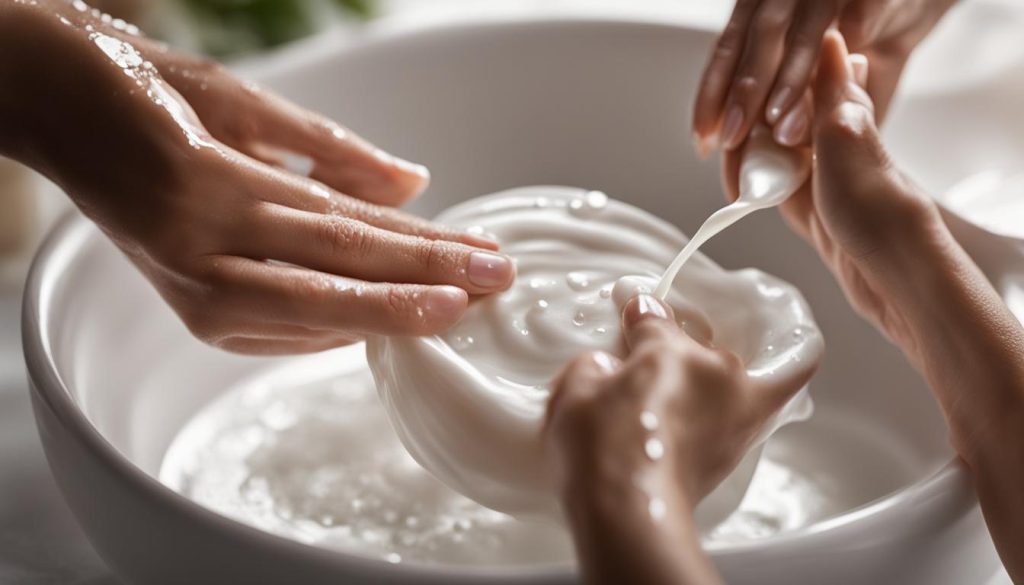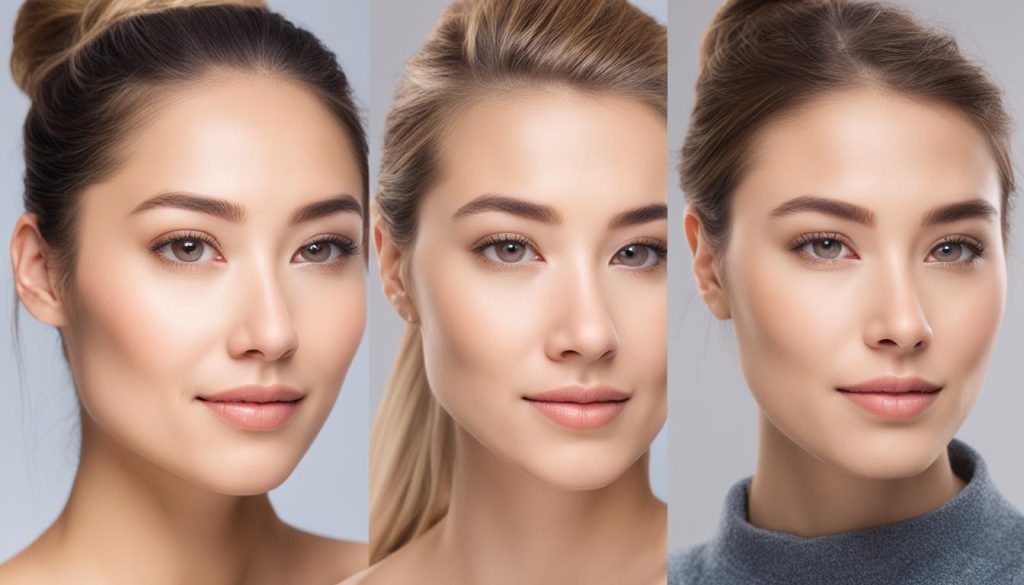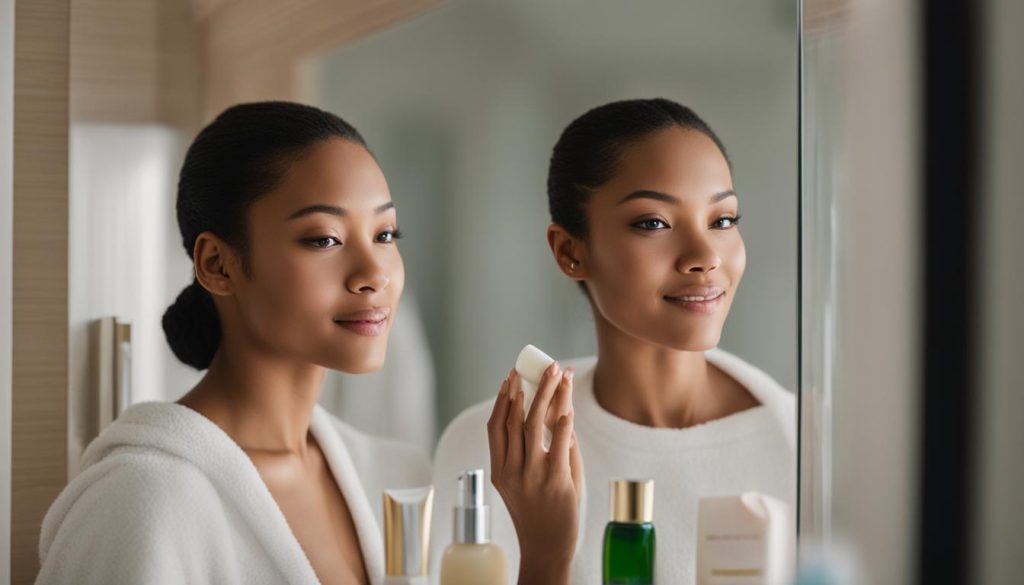As a long-time advocate of luminous, healthy skin, I’ve come to realize that the secret to achieving that covetable glow is deeply rooted in understanding and maintaining proper skin moisture. Nurturing our skin with the care it demands is more intricate than the simple act of splashing water on our faces. Skin dehydration – a culprit behind dullness and visible aging – can besiege us due to environmental elements like the harsh rays of the sun, biting wind, or even the air we breathe, laden with pollutants.
In cultivating my regimen, I’ve discovered that gentle cleansing paired with consistent, daily moisturization create an essential protective barrier. These practices harness the hydration benefits that our skin naturally craves, diminishing the signs of aging, and fortifying its suppleness. Dampened skin isn’t just a fleeting satisfaction post-wash; it’s a state of nourished, moisturized skin that can be sustained with targeted care. Integrating products that mesh well with our skin’s unique profile while applying them to wet skin for optimal absorption can turn the quest for hydrated skin from a dream into a reality.
Dampened Skin Care Tips
- Maintaining hydrated skin is integral to a youthful and radiant appearance.
- Use gentle cleansers to avoid stripping the skin of its natural oils.
- Apply moisturizer to damp skin to lock in moisture more effectively.
- The correct order of skin care product application is crucial for optimized skin hydration.
- Harnessing the power of moisturizing ingredients aids in creating a protective barrier.
- Adopting skincare habits that align with our skin’s needs leads to prolonged moistened skin benefits.
The Importance of Keeping Skin Hydrated
As a dedicated proponent of comprehensive skin health, I understand the monumental impact hydration has on maintaining a resilient and youthful complexion. Delving into the specifics of why hydration is crucial not only leads to dry skin relief but also enhances the approach to skin conditioning, enabling long-term skin rejuvenation.
Understanding Dehydration in Skin and Its Effects
The battle against dehydrated skin begins with recognizing the symptoms and underlying causes. Internal and external factors contribute to this predicament, ranging from the rigors of extreme weather to the daily attack of environmental pollutants. The resulting lack of moisture can escalate skin irritation and prematurely herald the onset of wrinkles and fine lines. Here, dry skin relief isn’t just a luxury—it’s a necessity for maintaining a portrait of health.
Healthy Hydration vs. Environmental Damage
One might ponder, “Should you apply moisturizer to wet skin?” This practice is beneficial beyond compare because it traps water on the skin’s surface, locking in the moisture to thwart environmental damage. Amidst the protective realm of skin conditioning, there lies a delicate balance between hydrating the skin—imparting it with essential moisture—and moisturizing—creating a barrier to retain this vital hydration.
The Role of Diet and Water Intake in Skin Health
To support nourished skin, one must not overlook the power of a balanced diet and ample water intake. Emanating radiance from within, the skin is a reflection of our nutritional habits—one cannot simply rely on topical treatments for skin rejuvenation. A regimen comprising nutrient-dense foods and significant hydration levels paves the way for a fortified and vibrant epidermis.
My commitment to skin health is reflected in the practice of using meticulously selected products and following a lifestyle that venerates the precepts of hydration. Through this holistic approach, we can bask in the glory of nourished skin, impervious to the relentless passage of time.
Hydrating Versus Moisturizing: A Vital Distinction
Understanding the difference between hydrating and moisturizing is fundamental for anyone looking to achieve optimal skin health. While these terms are often used interchangeably, they actually describe two unique processes that are key to maintaining a vibrant and youthful complexion. So, should your face be wet when applying moisturizer? Let’s delve into the specific functions that hydration and moisturizing serve in our skin care routine.
Hydrating the skin is about infusing your cells with water, which enhances their ability to absorb nutrients and maintain a plump, resilient appearance. Think of it as quenching your skin’s thirst. Hydrating products are typically water-based and might include ingredients like hyaluronic acid or glycerin that excel at drawing moisture into the epidermal layers. For best results, these serums and lotions should be applied to moist skin, creating an environment that helps to maximize absorption and aids in delivering that all-important moisture deep into the skin’s surface.

In contrast, moisturizing acts as a sealant to lock in the hydration that you’ve just introduced. It typically involves oil-based products that reinforce your skin’s natural barrier and prevent the evaporation of the newly added moisture. When it comes to moisturizers, it is crucial that they are applied to the skin once hydration has been addressed. Not only does this help to trap in moisture, but it also works to shield the skin against environmental stressors.
If you’re wondering whether lotion on wet skin is a good practice, consider this: applying a lotion right after bathing on slightly damp skin can bridge the gap between hydrating and moisturizing, effectively capturing the water content before it evaporates. This technique is especially beneficial for those with dry or dehydrated skin, granting an extra boost of hydration before it is sealed by a moisturizer.
- Apply hydrating products right after cleansing while the skin is still moist.
- Wait a few minutes, then follow up with a moisturizer to lock in the hydration and fortify the skin’s barrier.
- Consider ingredients like ceramides and fatty acids in moisturizers for optimal protection against moisture loss.
In summary, while both hydration and moisturization are crucial for maintaining a healthy skin ecosystem, understanding the delicate balance between the two is key. Remember that keeping your face and skin slightly wet when applying moisturizer might just be the secret tip for maximizing the hydrating vs moisturizing benefits of your skin care regimen.
Essential Steps for Achieving Dampened Skin
Embarking on a quest for hydrated skin, I begin with a routine that maximizes moisture retention and fortifies the skin’s barrier. It’s a process fine-tuned by personal experience and substantiated by skincare experts. It involves meticulous selection of lotions and serums, along with a deliberate application sequence to ensure optimal skin health.

Selecting the Right Cleanser for Hydration
My journey starts with choosing a gentle, water-based cleanser. The aim is not just to clean, but to maintain the crucial balance of natural oils within my skin. This careful selection sets the stage for subsequent hydration. It’s important to remember that vigorous cleansers can strip the skin of moisture, leading to a dry and tight sensation, which I conscientiously avoid.
The Right Way to Exfoliate for Moisture Retention
Progressing to exfoliation, I employ a method that sloughs away dead skin cells without over-stripping. This results in a smoother skin texture and enhances my skin’s ability to absorb moisture deeply. Regular exfoliation is integral to my regimen, paving the way for the skin layers beneath to revel in hydration.
The Significance of Using Toner and Essence
Following cleansing and exfoliation, I reach for a toner or essence. Their main function? To restore my skin’s pH balance and prime it for additional hydration. By fortifying the skin’s surface, these pivotal products lay a receptive foundation for the layers to come.
Applying Serums and Masks to Damp Skin
When my face is still damp, that’s the perfect canvas for the application of serums. Can you use any lotion on wet skin? The key is in the serum’s formulation. For instance, vitamin C on wet or dry skin is still effective. However, products like serums, which are rich in actives, penetrate more efficiently when the skin is moist. As for niacinamide, do you put it on wet or dry skin? I find damp skin to be more conducive for this ingredient as well.
Moisturizing: Locking Hydration into Your Skin
The final step is about **sealing in** all that goodness. With my skin still tender from gentle patting, I apply a moisturizer tailored to my skin’s needs, focusing on one that fosters barrier repair. Ingredients such as ceramides and fatty acids are my allies here. Whether I’m **putting lotion on wet skin** or applying a thicker cream, the goal remains unaltered: to lock in hydration for a lasting, supple feel.
Lifestyle Adjustments to Enhance Skin Hydration
As I delve into skin hydrating tips, I recognize that achieving optimal hydration is as much about my daily habits as it is about my skincare routine. Simple lifestyle changes can dramatically improve skin health, offering effective dry skin remedies and long-lasting skin hydration tips.
- Shortening my showers to a brisk few minutes and lowering the temperature helps my skin retain its natural lipids, preventing the over-drying that can occur with prolonged, hot water exposure.
- Ensuring I drink plenty of water each day directly influences my skin’s elasticity and overall hydration, keeping it looking plump and youthful.
- Maintaining a diet abundant in nutrients essential for skin health, such as Vitamin A, E, and Omega-3, fortifies my skin from the inside out.
- I’ve also learned how timing matters in skincare application. For instance, applying vitamin C before toner can interfere with the pH balance necessary for optimal absorption—but strategically layered, they enhance each other.
Another crucial aspect I focus on is how to make skincare absorb better. Products work best when the skin is primed to receive them. I use a toner to balance my skin’s pH and then apply a serum while my skin is still damp. This method greatly increases the absorption of active ingredients, maximizing their benefits.
In addition to these steps, I’ve incorporated a humidifier into my bedroom, which adds moisture to the air, especially during the drier, colder months. It’s a simple step that makes a significant difference in maintaining my skin’s hydration levels.
- Start your morning with a tall glass of water to jump-start hydration.
- Follow with a well-balanced breakfast, including items such as avocado toast, rich in healthy fats for your skin.
- Before your skincare routine, splash your face with water—never too hot nor too cold.
By mindfully incorporating these modifications into my life, every day becomes an opportunity to improve my skin’s hydration and, consequently, its health and appearance.
Conclusion
In my journey to unveil the secrets behind achieving a resilient and radiant complexion, I’ve traversed the pathways of dampened skin care with meticulous attention to detail. Understanding the meticulous dance between skin hydration and moisturization has not just been educational but transformative. I’ve discovered that the essence of healthy, moistened skin emerges from the confluence of knowledgeable product selection and mindful lifestyle habits that cater to the skin’s thirst for balance.
Summarizing the Journey to Hydrated, Nourished Skin
Where once I mistook temporary relief for genuine skin nourishment, I now recognize that the true path to sustained skin moisturization weaves through daily practices. These practices range from conscientiously chosen hydrating skin care routines to the disciplined consumption of water and nutrients. My skin, once pleading for wet skin remedies, now flourishes under the regimen that I’ve meticulously crafted, replete with products tailored for maximum absorption and efficacy.
The Long-term Benefits of Dampened Skin Care
The dividends of persisting on this route are undeniable—a strengthened skin barrier, an increase in texture quality, and the coveted youthful glow that many aspire to achieve. Dry skin relief was merely the starting point; the holistic care that followed has unveiled an avenue for enduring skin health. As I continue to champion these principles of moisturization and hydration, the realization stands firm: the dedication to maintaining a consistent, dampened skin care ethos is quintessential for not just the now, but also fortifying my skin’s future.
FAQ
Should you apply moisturizer to wet skin?
Yes, it’s beneficial to apply moisturizer to wet skin. Doing so can help lock in the moisture from the water, which can aid in skin hydration and give you richer results from your moisturizer.
Is it good to apply moisturizer on a wet face?
Applying moisturizer to a wet face is indeed good, as it helps to trap the water on the skin’s surface, boosting hydration and effectiveness of the moisturizing product.
Can you use any lotion on wet skin, or does it need to be specific?
While many lotions can be applied to wet skin, some formulations are specifically designed to be absorbed on damp skin. It’s always best to check the product’s instructions for optimal use. However, as a general rule, thicker creams might fare better on slightly drier skin while lighter lotions are more easily absorbed on wet skin.
Do you put vitamin C on wet or dry skin?
Vitamin C serums are typically best applied to dry skin. Moisture can dilute the formula, potentially affecting its efficacy. For optimal absorption and results, apply vitamin C serum to clean, dry skin before using other moisturizing products.
Should your face be wet when applying hydrating serums?
Yes, applying hydrating serums on a face that is still damp can be beneficial as it helps improve the serum’s absorption into the skin.
Do you put niacinamide on wet or dry skin?
Niacinamide can be applied to either wet or dry skin, but some find that applying it to damp skin helps with absorption. It’s often best to follow the instructions provided by the product’s manufacturer.
How does vitamin C fit into my skincare routine, before or after toner?
Vitamin C should typically be applied after toner. The toner helps to balance the skin’s pH and prep the skin for other treatments, allowing the vitamin C to be better absorbed when applied afterward.
How can you make your skin care absorb better?
To enhance absorption of skin care products, begin by cleansing and exfoliating to remove dead skin cells. Then, apply products to damp skin, layering from thinnest to thickest consistency. Additionally, using products formulated with ingredients that aid in absorption, such as hyaluronic acid, can improve your skin care’s efficacy.
What are some effective dry skin remedies?
Effective dry skin remedies include using gentle cleansers, applying thick moisturizers immediately after showering, using a humidifier in dry environments, and increasing water intake. Additionally, avoiding hot showers and selecting skin care products tailored for dry skin can assist in alleviating dryness.
What lifestyle adjustments can enhance skin hydration?
Lifestyle adjustments that can enhance skin hydration include drinking plenty of water, maintaining a balanced diet rich in fruits, vegetables, and healthy fats, reducing alcohol and caffeine intake, and protecting the skin from harsh weather by using appropriate skincare products.






